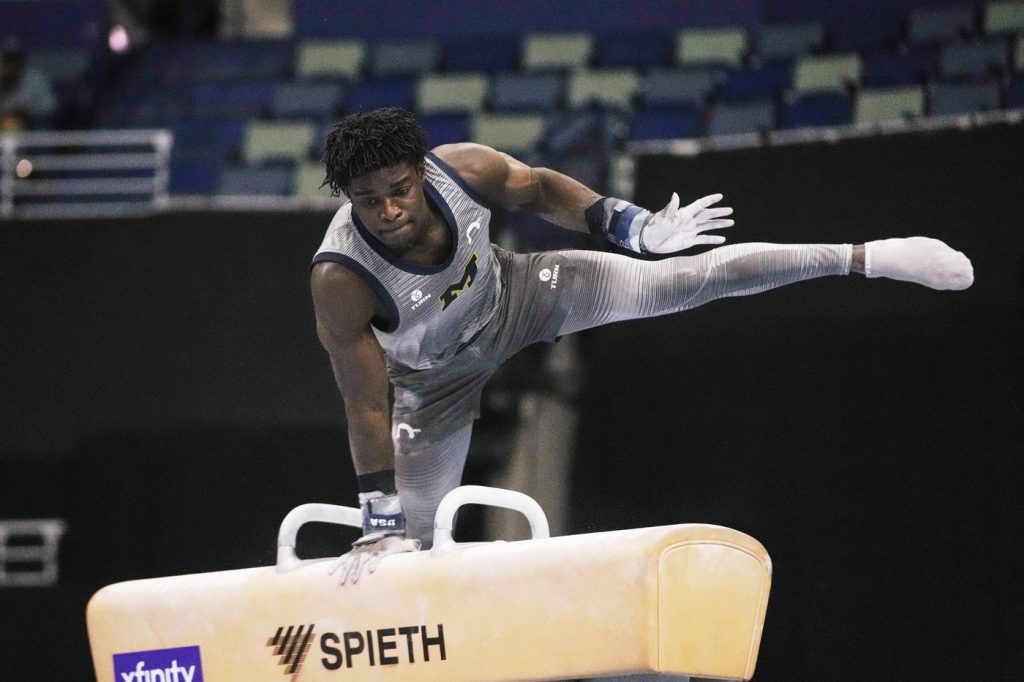NEW ORLEANS (AP) — Frederick Richard, a 21-year-old Olympic bronze medalist, is making waves in the world of men’s gymnastics by transforming not just how he performs but also how he dresses. At the recent U.S. Championships, Richard opted for shorts with compression leggings instead of the traditional stirrup pants that have defined men's gymnastics uniforms. He is fully aware that this choice incurs a three-tenths (0.3) deduction in his scores but believes it's a worthwhile trade-off to modernize the sport and make it more appealing to younger audiences.
Richard narrowly secured second place behind two-time national champion Asher Hong, finishing just a quarter of a point ahead of Fuzzy Benas. If Richard had adhered to the traditional uniform, his ranking might have been more secure. Yet, he stands firm in his conviction that the need for men’s gymnastics to evolve is far greater than any potential loss of placement. “It’s 1,000% worth it,” Richard stated, emphasizing his desire for young viewers to see gymnastics as a cool and relatable sport.
Growing up in Boston, Richard found joy in gymnastics, yet felt embarrassed by the stirrup pants worn in competition. “I didn’t want anybody to see me in my pommel horse pants,” he recalled, explaining that he often felt the need to hide his identity as a gymnast from peers. To combat this, he collaborated with the apparel company Turn to develop an alternative uniform. During the 2023 national championship, he first unveiled a look featuring maize-and-blue zebra-patterned leggings paired with matching blue shorts, later switching to gray. Despite incurring the uniform deduction, Richard remained more interested in inspiring the boys in the audience to see gymnastics as engaging and fashionable.
While the popularity of men's gymnastics has considerably declined in the U.S., the narrative surrounding uniforms remains largely absent in countries like China, Japan, and Russia, where gymnastics continues to be celebrated. Pressure on men’s gymnastics in the U.S. includes a reduction in the number of Division I programs offering scholarships, exacerbated by ongoing policy changes that threaten the traditional feeder system to national teams. Richard acknowledges this context, underscoring his observation of boys leaving the sport for more socially accepted alternatives like football or soccer.
Richard is not alone in his views. Fellow gymnast Stephen Nedoroscik, who has cemented his status as a star while adhering to traditional uniform standards, also believes that gymnastics should allow for some uniform flexibility. He recognizes the necessity for judges to see athletes in similar attire, but supports Richard’s call for a re-examination of clothing regulations in men’s gymnastics.
As Richard prepares for future competitions, including potential international events, he navigates the balance between adhering to established regulations and pushing for change. While he plans to wear his innovative outfit, he remains committed to traditional attire when participating in team competitions. “We’ll have to talk and see what they allow, but I want to keep pushing it,” Richard expressed, noting his ambition to influence the sport’s evolution positively.
Despite some backlash regarding his choices, Richard shows no signs of backing down. He has stated, “I’ll wear it for the next 10 years if I have to,” indicating his determination to foster interest in gymnastics among younger audiences. By doing so, he hopes that the aesthetic appeal of gymnastics will gradually shift, enabling future generations to view the sport through a more modern lens.










